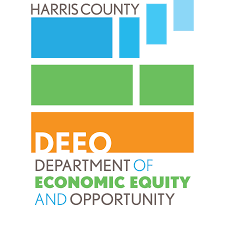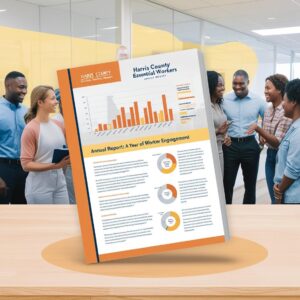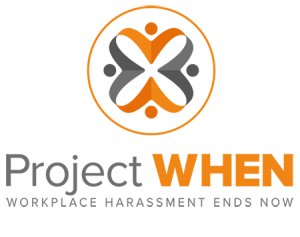Communication at the Core: Harris County’s Texas Essential Workers Board as a Model for Worker Engagement
 In 2022, Harris County, Texas, launched a groundbreaking Essential Workers Board (HCEWB) in direct response to the COVID-19 pandemic’s revelation of gaps in worker representation. Essential workers – from healthcare staff to grocery clerks – had borne the brunt of the crisis without a formal voice in policy decisions. County officials, led by Judge Lina Hidalgo, recognized the need for a structured channel of communication between these front-line workers and the government. In November of 2021, the Commissioners Court approved the creation of HCEWB – the first body of its kind in the nation – to give essential workers a seat at the table in shaping local policy By early 2022 the board was up and running, designed as a participatory governance model to ensure that the lived experiences of essential workers inform pandemic recovery and beyond. This case study examines how communication has been the central strategy in making the HCEWB a successful conduit for worker engagement and policy influence, and how its structure offers a replicable model for other jurisdictions.
In 2022, Harris County, Texas, launched a groundbreaking Essential Workers Board (HCEWB) in direct response to the COVID-19 pandemic’s revelation of gaps in worker representation. Essential workers – from healthcare staff to grocery clerks – had borne the brunt of the crisis without a formal voice in policy decisions. County officials, led by Judge Lina Hidalgo, recognized the need for a structured channel of communication between these front-line workers and the government. In November of 2021, the Commissioners Court approved the creation of HCEWB – the first body of its kind in the nation – to give essential workers a seat at the table in shaping local policy By early 2022 the board was up and running, designed as a participatory governance model to ensure that the lived experiences of essential workers inform pandemic recovery and beyond. This case study examines how communication has been the central strategy in making the HCEWB a successful conduit for worker engagement and policy influence, and how its structure offers a replicable model for other jurisdictions.
The Initiative: Structure, Mission, and Governance
The Harris County Essential Workers Board was established as an official advisory board under the County’s Department of Economic Equity and Opportunity (DEEO). Its mission is straightforward yet ambitious: to advise county government on programs and policies that affect essential workers’ health, safety, and economic well-being The HCEWB is empowered to make non-binding recommendations to county departments and the Commissioners Court, ensuring that decision-makers consider workers’ voices when crafting policy.
The board is composed of 13 members, all of whom are essential workers or have recent essential work experience in Harris County. Formally, the HCEWB’s purpose is to “recognize and support essential workers” by providing feedback on county initiatives. In practice, this means the board examines how Harris County’s decisions – whether on emergency preparedness, workplace health and safety, fair wages, or economic recovery programs – impact workers on the ground. The board’s objectives include: evaluating existing and proposed programs, sharing information and first-hand insights from the front lines, and serving as a public forum to discuss essential workers’ rights.
Notably, the HCEWB was chartered to focus on both crisis situations (like public health emergencies) and everyday labor issues (like wage fairness and workplace safety), reflecting lessons learned from the pandemic. While the board’s recommendations are advisory, Harris County’s leadership has treated the HCEWB as a crucial partner in policy development, embedding this worker-centered body within the county’s governance structure.
A Communication-Centered Approach to Bridging Gaps
From its inception, the HCEWB has placed inclusive communication at the heart of its strategy. The board’s very existence is about creating dialogue – between workers and county officials, among workers from different sectors, and with the public. Three pillars of the board’s communication approach are regular public meetings, transparent reporting, and proactive community engagement.
- Regular Public Meetings: The HCEWB meets on a consistent schedule, which the board itself voted to set with flexibility for members’ needs. Meetings are typically held during evening hours, a deliberate choice so that working members and community attendees can participate outside of standard work shifts. All meetings are open to the public and serve as a two-way communication forum. Essential workers and residents can attend (in person or via a virtual option) to share comments, and county representatives can hear concerns first-hand.
Notably, the board provides Spanish interpretation at every meeting, recognizing that many front-line workers in Harris County are more comfortable conversing in Spanish. Agendas are posted in advance, and any member of the public who wishes to speak can sign up ahead of time to ensure their voice is heard within the meeting’s timeframe. These practices of open meetings, hybrid attendance, and language access demonstrate how the HCEWB lowers barriers and actively invites participation.
- Transparent Annual Reports: Communication isn’t limited to meetings. Each year, the HCEWB distills its work into an annual report to Commissioners Court and the public. This report summarizes the board’s goals, activities, findings, and recommendations. For example, the 2023 Annual Report recounts the board’s early challenges and accomplishments – from filling vacant seats to launching policy training for members – and lays out goals for the coming year.
It serves as a written record of worker input over the year, ensuring county officials formally receive the board’s advice. By documenting concerns and proposals in writing, the HCEWB creates accountability for its recommendations. The annual reports also highlight narratives that emerged from board discussions, giving a broader audience insight into essential workers’ lived realities.
This regular communication tool reinforces that the board is not a static committee but an active, results-oriented body. County leaders have responded: when the board flagged the need for better recruitment, Precinct Commissioners collaborated to help fill the gaps and when training needs were identified, resources were provided. The iterative loop of listen – document – act is central to the board’s influence.
- Community Outreach and Forums: Beyond formal meetings and reports, the HCEWB embraces less formal avenues of communication to engage workers in the broader community. In its first year, for instance, the board held a virtual kickoff in coordination with worker advocacy groups to introduce the initiative and hear immediate concerns from essential workers countywide.
Board members have also attended external workshops and listening sessions to broaden their perspective – one member participated in a UCLA Labor Occupational Safety & Health Program convening to connect with peers from around the country. These exchanges allow the HCEWB to import new ideas and best practices while exporting their own model to others.
Locally, the board positions itself as a platform where any essential worker can voice issues. While still a new entity, HCEWB has discussed holding targeted public forums (for example, town halls on workplace safety or listening sessions on pandemic recovery) to gather input outside of regular meetings. Even in Commissioners Court meetings, HCEWB members often speak during public comment on worker-related agenda items, effectively acting as messengers between the workforce and elected officials.
This consistent emphasis on communication – whether through formal testimony, community events, or networking with national experts – has been the lifeblood of the HCEWB. It not only informs the board’s own recommendations but also builds credibility: essential workers see that someone is listening, and officials see a well-informed, united worker voice emerging.
Underlying all these efforts is a commitment to inclusive, participatory communication. Harris County equipped board members with tools like iPads and mobile hotspots to ensure they could participate remotely and stay connected between meetings. Translation of materials and live interpretation ensure everyone can contribute in their preferred language. Even the terminology used in meetings is adjusted to be worker-friendly rather than bureaucratic.
By meeting workers where they are – literally and figuratively – the HCEWB exemplifies how thoughtful communication practices can bridge gaps between ordinary people and government. This approach has begun to erode the traditional barriers that left low-wage and marginalized workers unheard, replacing them with bridges of understanding.
Modeling Participatory Governance Through Worker Voice
The HCEWB offers a powerful example of participatory governance: policy development that actively involves the people affected – in this case, the workers. At the heart of this model is the idea that those with lived experience in essential jobs should help shape the rules and programs that govern those jobs. Harris County operationalized this idea by bringing real workers into the policy-making process and valuing their communication as expert testimony.
- Bringing Lived Experience into Policy: Every HCEWB member carries the stories of their workplace and community into board discussions. By design, a home care provider can detail the challenges of caring for clients without proper protective equipment, or a grocery clerk can describe the stress of working through a hurricane or pandemic.
These first-hand accounts, shared in meetings and reports, put a human face on policy issues. They shift discussions from abstract terms to concrete realities – for instance, an agenda about “occupational safety” transforms into a dialogue about heat stress experienced by a delivery driver on a 100°F day, or a conversation about “pandemic response” centers on a nurse aide’s story of insufficient PPE.
Such narrative examples equip the board to make nuanced policy recommendations. In its advisory role, the HCEWB has elevated issues like these to County leadership. One early focus area was the county’s contracting standards – after hearing from construction and janitorial workers about unsafe conditions, the board began reviewing Harris County’s Contractor Safety Record Policy to suggest improvements.
The result: by 2023 the County had implemented new requirements for contractors to provide OSHA safety training to their employees on county projects, and it is evaluating bidders’ safety records before awarding contracts. While multiple factors contributed to these changes, the Essential Workers Board’s input and consistent messaging on worker safety helped drive home the point that safety must be a priority. In short, the lived experiences conveyed by HCEWB members translate into concrete policy influence, whether it’s safer worksites, better emergency plans, or more equitable economic programs.
- Ensuring Inclusive Representation: A key reason the board’s advice carries weight is its representative makeup. Harris County intentionally assembled the HCEWB to mirror the county’s essential workforce across race, ethnicity, gender, geography, and industry.
This diversity is not just a box to check – it is fundamental to the board’s legitimacy and effectiveness. Community trust in the board hinges on people seeing “someone like me” on it. Indeed, board makeup matters for credibility: to be trusted in the community, the board must look and sound like the community. Harris County’s approach recognized this, ensuring members hail from different neighborhoods and backgrounds.
This inclusive composition means that when the HCEWB presents recommendations, officials know the advice isn’t coming from a narrow group but from a cross-section of Harris County’s frontline heroes. This breadth of representation strengthens policy design by incorporating varied needs – a proposal will have considered how it affects a school teacher, a rideshare driver, and a home health aide, not just one subset. It’s participatory governance in action: those normally marginalized in policy debates are actively co-creating solutions.
- From Recommendation to Impact – Examples: Though still relatively new, the HCEWB has begun to make its mark on Harris County policy. One salient example is the historic living wage increase passed by the Commissioners Court in 2025.
This policy raised the minimum pay for Harris County employees to $20/hour (and $21.65 for contractor employees) – a significant boost aimed at thousands of frontline workers. The Essential Workers Board played an important role in shaping and advocating this change. Board members provided testimony and data on how the rising cost of living was outpacing wages for essential workers, bringing real stories of hardship into budget discussions.
Commissioners credited those insights as helping build the case for change, noting that hearing directly from affected workers made the need undeniable. The wage increase policy passed unanimously, signaling the influence that organized worker input, channeled through the HCEWB, had on county decision-making.
Other examples include the aforementioned OSHA training requirement for contractors, which aligns with the board’s recommendations for a safer workplace, and Harris County’s ongoing development of emergency response protocols that incorporate essential worker input (the board has advised on how to protect workers in future public health emergencies, drawing lessons from COVID).
Even in areas like allocation of federal COVID relief funds, the HCEWB has provided feedback to ensure funds reach low-income workers in need. In each case, the board serves as a conduit for workers’ voices to shape policy, exemplifying participatory governance. Policies are not simply handed down to workers; they are developed with workers.
Impact and Replication of the HCEWB Model
In just a few years, Harris County’s experiment in collaborative governance is showing clear impacts locally and is inspiring imitation elsewhere. Inside Harris County, the Essential Workers Board has fostered a stronger culture of worker-centered policy.
County agencies now routinely consider the “worker impact” of programs, a perspective reinforced by HCEWB’s constant feedback. There is evidence of a shift toward more proactive protection of workers: for instance, the County’s contractor safety evaluation criteria and living wage policy (described above) are tangible improvements influenced by worker input.
Less tangibly but as importantly, there’s an increase in trust and engagement. Essential workers who may have felt invisible to the government now have champions in the HCEWB amplifying their concerns. Commissioners Court benefits from this direct line of communication – rather than guessing what communities need, they receive informed suggestions from the board.
As Harris County Attorney Christian Menefee put it, “higher wages are not just about improving individual lives; they have a ripple effect” in the community, and policies like these are more likely to succeed when those at the center (the workers) buy in. The HCEWB has helped secure that buy-in by involving workers from the start. Moreover, the board’s presence has increased transparency. Worker issues that might once have been confined to break rooms or protests are now discussed in public meetings with official follow-up. This kind of open, structured engagement is making Harris County a leader in labor innovation.
 Communication Lessons from HCEWB
Communication Lessons from HCEWB
Harris County’s experience with the Essential Workers Board yields several key lessons about communication, inclusion, and governance that can inform similar initiatives elsewhere:
- Direct communication builds legitimacy: When workers can speak directly to policymakers (rather than through layers of bureaucracy), it creates mutual respect and credibility. The HCEWB’s practice of open forums and unfiltered worker testimony has made county officials more responsive and made workers feel truly heard.
This direct line of communication has been critical for the board’s legitimacy. County program manager Danielle Igbani noted that the board members feel a sense of ownership – “the board exists because of them” – precisely because they drive the conversations. Likewise, the community trusts the board’s voice because it’s authentic.
An important takeaway is that face-to-face (or voice-to-voice) dialogue humanizes policy. Hearing a nursing aide describe a 14-hour shift in her own words is far more impactful than reading a statistic. Such communication not only informs better decisions but also builds public trust in those decisions.
- Inclusion strengthens policy design: The breadth of representation in the HCEWB has directly translated into more robust policy recommendations. By including voices across race, gender, and industry, the board avoids one-size-fits-all solutions. Instead, it identifies inclusive strategies that account for different realities on the ground.
This reflects a broader lesson: diversity is a strength in policy-making. When a policy is co-crafted by people of varied backgrounds – a teacher, a construction worker, a gig driver, a domestic worker – it’s more likely to be equitable and broadly effective. Harris County learned that people-centered design is critical: it’s not enough to have good intentions; one must design the process to uplift those who usually lack power.
That meant providing translators, stipends, and tech access so all board members could engage fully. The result is better ideas and fewer blind spots. In short, inclusive communication (making sure everyone at the table can participate confidently) leads to inclusive outcomes. As one New York lawmaker put it, “Any policies that are made for workers need to be developed with workers at the table.”– HCEWB embodies this maxim, and its successes underscore that nothing about us without us is smart policy strategy.
- Advisory bodies as vehicles for transparency and co-governance: The HCEWB demonstrates how forming an official advisory board of workers can institutionalize transparency and shared governance. Rather than worker issues being raised only in protests or afterthoughts, the board provides a standing, formal venue for worker-government interaction.
This arrangement creates a record (through meeting minutes and reports) of what is being requested and how the government responds, holding both sides accountable. It also embeds a culture of co-governance, where policy is not solely top-down but co-created. Other cities have used similar boards to conduct public hearings, outreach, and issue reports, which often carry legal weight for further action.
Harris County’s innovation was to do this across sectors at a county scale. The lesson is that when you give workers an official mandate to participate in governing processes, you get more transparent decision-making and policies that are more rigorously vetted. Additionally, advisory boards like HCEWB serve as an early-warning system for emerging issues, increasing the government’s responsiveness. This kind of partnership moves us toward a more democratic form of governance at the local level – one where transparency, accountability, and collaboration with the community are the norm, not the exception.
Conclusion
The Harris County Essential Workers Board shows that making communication and an inclusive structure the cornerstones of an initiative can turn lofty ideals of “worker voice” into a working reality. By carefully constructing a space for dialogue – equipping it with the right tools, representative people, and genuine authority – Harris County has created a scalable model for worker engagement in governance.
The HCEWB is not just a feel-good committee but a functioning bridge between those on the front lines and those in the halls of power. Its impact on policies like workplace safety rules and living wage standards illustrates how structured communication leads to concrete change. And its growing reputation on the national stage indicates that others can replicate and build on this model.
In the end, the success of HCEWB comes down to more than good intentions – it’s about the systems and channels put in place to act on those intentions. Harris County’s approach of centering communication (through open meetings, reports, and outreach) and backing it with supportive structure (bylaws, diverse representation, resources for participation) has created an empowered board of essential workers that can engage as equal stakeholders with the government. This formula – voice, inclusion, and structure – is one that any community can adapt.
As the first experiment of its kind, the HCEWB has proven that essential workers, when given a platform and listened to intently, can greatly inform and improve public policy. In a world still recovering from a pandemic and looking to build resilience for the future, Harris County’s Essential Workers Board offers a hopeful blueprint: governing with the people most affected, through constant communication and collaboration, is not only possible but powerful. It’s a model in which communication isn’t just an afterthought – it is the driving force that turns participation into influence and lasting change for workers and communities alike.
Ready to Elevate Your Agency’s Public Communication?
We understand the unique challenges state and local government agencies face—from complex issues to diverse community needs. Our comprehensive approach can help you transform the way you connect with constituents, improve transparency, and highlight the valuable work your agency does every day.
Interested in learning more? Reach out to us today for a consultation. We’d love to discuss how our services can support your goals and help you build lasting trust with the communities you serve.



 Communication Lessons from HCEWB
Communication Lessons from HCEWB

